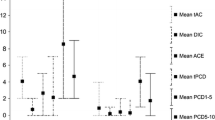Abstract
Sister chromatid exchange (SCE) frequency and high-frequency cells (HFCs) were analyzed in 50 storage battery plant workers with mean blood lead level (BLL) of 40.14±9.99 μg/dL. The mean BLL in the control group (n=30) was 9.77±1.67 μg/dL. This difference in mean BLLs between control and exposed group was statistically significant (p<0.05) and reflects clearly the lead exposure in the workers. Urinary aminolevulinic acid (U-ALA) was also determined in both control (3.37±0.89 mg ALA/g creatinine) and exposed groups (12.39±6.18 mg ALA/g creatinine) and U-ALA excretion was statistically higher (p<0.05) in lead-exposed workers. The relationship between biomarkers of lead exposure/effect and HFC percentage was higher than the relationship between biomarkers of lead exposure/effect and SCE frequency. Accordingly, HFC analysis seemed to be more sensitive than the SCE analysis as a cytogenetic biomarker for lead exposure. Additionally, the statistically significant correlation (r 2=0.880, p<0.01) between U-ALA excretion and HFC percentage in lead-exposed workers supported the probability of ALA mediated indirect mechanism for lead genotoxicity.
Similar content being viewed by others
References
F. M. Johnson, The genetic effects of environmental lead, Mutat. Res. 410, 123–140 (1998).
C. Winder, and T. Bonin, The genotoxicity of lead, Mutat. Res. 285, 117–124 (1993).
Y. Duydu, H. S. Süzen, A. Aydin, et al., Correlation between lead exposure indicators and sister chromatid exchange (SCE) frequencies in lymphocytes from inorganic lead exposed workers, Arch. Environ. Contam. Toxicol. 41, 241–246 (2001).
Y. Duydu, and H. S. Süzen, Influence of δ-aminolevulinic acid dehydratase (ALAD) polymorphism on sister chromatid exchange (SCE) frequencies and high frequency cells (HFCs) in lymphocytes from lead exposed workers, Mutat. Res. 540, 79–88 (2003).
H. S. Süzen, Y. Duydu, A. Aydin, A. Işmer, and N. Vural, Influence of the deltaaminolevulinic acid dehydratase (ALAD) polymorphism on biomarkers of lead exposure in Turkish storage battery manufacturing workers, Am. J. Ind. Med. 43, 165–171 (2003).
Y. Hiraku, and S. Kawanishi, Mechanism of oxidative DNA damage induced by aminolevulinic acid in the presence of copper ion, Cancer Res. 6, 1786–1793 (1996).
T. Douki, J. Onuki, M. H. G. Medeiros, E. J. H. Bechara, J. Cadet, and P. D. Mascio, DNA alkylation by 4,5-dioxyvaleric, the final oxidation product of 5-aminolevulinic acid, Chem. Res. Toxicol. 11, 150–157 (1998).
Y. Duydu, and N. Vural, Urinary excretion of lead and delta-aminolevulinic acid in workers occupationally exposed to tetraethyllead, Biol. Trace. Element Res. 63, 185–194 (1998).
K. Tomokuni, and M. Ogata, Simple method for determination of urinary delta aminole-vulinic acid as an index of lead exposure, Clin. Chem. 18(12), 1534–1536 (1972).
A. V. Carrano, and D. H. Moore, The rationale and methodology for quantifying sister chromatid exchange in humans, in Mutagenicity: New Horizons in Genetic Toxicology, J. A. Heddle, ed., Academic, New York, pp. 267–304 (1982).
D. H. Moore, and A. V. Carrano, Statistical analysis of high SCE frequency cells in human lymphocytes, in Sister Chromatid Exchanges Part A. The Nature of SCE’s, R. R. Tice and A. Hollaender, eds., Plenum, New York, pp. 469–479 (1984).
A. Vaglenov, A. Creus, S. Laltchev, V. Petkova, S. Pavlova, and R. Marcos, Occupational exposure to lead and induction of genetic damage, Environ. Health Perspect. 109(3), 295–298 (2001).
J. Palus, K. Rydzynski, E. Dziubaltowska, K. Wyszynska, A. T. Natarajan, and R. Nilsson, Genotoxic effects of occupational exposure to lead and cadmium, Mutat. Res. 540, 19–28 (2003).
F. Y. Wu, P. W. Chang, C. C. Wu, and H. W. Kuo, Correlations of blood lead with DNA-protein cross-links and sister chromatid exchanges in lead workers, Cancer Epidemiol. Biomarkers Prev. 11, 287–290 (2002).
K. Danadevi, R. Rozati, B. S. Banu, P. H. Rao, and P. Grover, DNA damage in workers exposed to lead using comet assay Toxicology 187, 183–193 (2003).
E. Carbonell, F. Peris, N. Xamena, A. Creus, and R. Marcos, SCE analysis in human lymphocytes of a Spanish control population, Mutat. Res. 335, 35–46 (1995).
S. Bonassi, V. Fontana, M. Ceppi, R. Barale, and A. Biggeri, Analysis of correlated data in human biomonitoring studies. The case of high sister chromatid exchange frequency cells, Mutat. Res. 438, 13–21 (1999).
T. Sakai, Biomarkers of lead exposure, Ind. Health 38, 127–142 (2000).
R. Neil, P. Yang, J. Fiechtl, D. Yildiz, H. Gurer, and N. Ercal, Pro-oxidant effects of δ-aminolevulinic acid (δ-ALA) on Chinese hamster ovary (CHO) cells, Toxicol. Lett., 91, 169–178 (1997).
C. A. Costa, G. C. Trivelato, A. M. Pinto, and E. J. H. Bechara, Correlation between plasma 5-aminolevulinic acid concentrations and indicators of oxidative stress in lead-exposed workers, Clin. Chem. 43(7), 1196–1202 (1997).
Author information
Authors and Affiliations
Rights and permissions
About this article
Cite this article
Duydu, Y., Dur, A. & Süzen, H.S. Evaluation of increased proportion of cells with unusually high sister chromatid exchange counts as a cytogenetic biomarker for lead exposure. Biol Trace Elem Res 104, 121–129 (2005). https://doi.org/10.1385/BTER:104:2:121
Received:
Revised:
Accepted:
Issue Date:
DOI: https://doi.org/10.1385/BTER:104:2:121




